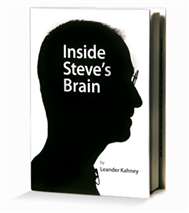 There are a lot of books about Apple culture—both inside and outside of the company. There are also a lot of (okay, some) books about Steve Jobs. But how many books about Steve Jobs are there by one of the more well-known Apple cultural anthropologists, author of the (in?)famous Cult of Mac and Cult of iPod books, Lander Kahney? Only one: Inside Steve's Brain.
There are a lot of books about Apple culture—both inside and outside of the company. There are also a lot of (okay, some) books about Steve Jobs. But how many books about Steve Jobs are there by one of the more well-known Apple cultural anthropologists, author of the (in?)famous Cult of Mac and Cult of iPod books, Lander Kahney? Only one: Inside Steve's Brain.
Published this April, the book attempts to do things a little differently than other Steve Jobs books, which tend to focus on revisiting a timeline in history up through today. Instead, Kahney focuses on different elements of Steve's personality in each chapter, and showcases evidence of those personality traits with the relevant tidbits of history. Through this, the reader is forced to think not just about what has happened, but why it happened the way it did, how it affects things at Apple today, and what, exactly, Steve has been thinking all these years.
Each chapter starts off well enough, and the stories are told in new and interesting ways that I haven't gleaned from past books (and please, let's not talk about my involuntary collection of Apple-related history books. For some reason, people in my life keep thinking that I need more as gifts). For example, Kahney directly addresses the rumor that Steve Jobs has a penchant for firing people in elevators (his exhaustive research did not turn up a single person that this had happened to, personally, although everyone had heard about it from a friend of a friend).
He also talks about some of the decisions made within the company on how to handle PR for different products, and goes into detail about what kinds of lessons Steve took away from NeXT and Pixar and applied them back to Apple. And, let's not talk about the stinging failure of the Cube, which Jobs apparently took quite personally, the form factor of which was very intentionally resurrected in the design of NYC's 5th Avenue Apple Store. From a history perspective, I find the book to be quite insightful.
The problem, unfortunately, is exactly what I said was the point of the book earlier: it is not necessarily written in chronological order of events like other books focusing on Jobs' history. I kept finding myself getting wrapped up in the story being told—most certainly a good thing, especially for someone who has heard some of it before—only to be ripped out of it with some observations on how what I just read reflects some element of Steve's personality. Sometimes in order to do this, the book backtracks and looks at events that took place prior to the ones you have already read so far, so it can be a little confusing. For example, you can jump from 2004 to 1997 to 2007 all within the same page. The worst part is that I just kept falling for it over and over (you know what they say about sanity and repetition).
Because of this, I don't find Inside Steve's Head to be a particularly smooth read. It may also not be the best book to start with if you're just now deciding to learn about a linear history of Apple and Jobs. I do, however, think that Apple and Jobs enthusiasts would find it a welcome addition to their collections, as the information contained within is presented with the kind of detail that only an Apple fan could appreciate.
At the very least, check it out from the library and decide whether you want to add it to your own bookshelf.
Disclosure: Leander Kahney is an editor at Wired, which is owned by the same parent company as Ars Technica.
reader comments